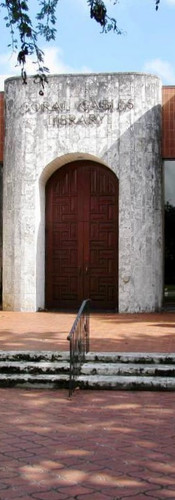OPEN SPACE
- Yulia Strokova

- Apr 15, 2021
- 4 min read
Updated: Sep 26, 2021
On how public libraries address digital equity and inclusion
By Kacie Brown

“If you spend an hour or two just walking through the stacks, you find so much history that is there to be discovered,” tells Ray Baker about his office. For the last four years, Ray has been managing the Miami-Dade Public Library System, where you can still stop time, feel the present, or jump to the future.
The first libraries in Miami were founded through the efforts of local women’s clubs who focused on securing book donations and requesting copies from authors around the world. The branch in Coral Gables is one of the oldest and most beautiful ones. The original building is of a contemporary Mediterranean style, including keystone from the Florida Keys, red clay roof tiles, Spanish clay floor tiles, wrought iron light fixtures, and Honduran mahogany doors.
The main reading room has 15-foot ceilings with exposed wood beams, and the Margaret M. Beaton meeting room houses a large and colorful mural of ceramic glazed tiles depicting local landmarks and native flora and fauna, created by artist Katherine French Pancoast in 1970.
Throughout the past century, the library system has grown from a reading room in Lemon City to 49 libraries spanning the county’s southernmost point in Naranja to its northern reaches in Sunny Isles Beach. The library system has also dramatically evolved in the way services are provided -- all in an effort to meet the informational, educational and recreational needs of locals.
The Coral Gables Branch Library is the “Castle of Good Reading”
The pandemic just enlarged their community efforts. While most co-working spaces and coffee shops (prime spaces for work other than the traditional office) had closed, the libraries’ team instead leveraged their resources for residents.
Internet access transformed from a service into an absolute necessity. In response, the MDPLS offered free WiFi outside their 50 locations. Anyone could drive up to connect, whether they have a library card or not.
At 26 MDPLS locations, residents facing economic distress could pick up free envelopes and paper copies of the applications for unemployment benefits and SNAP, which provides nutrition assistance for low-income residents. They then could return the completed applications to their library’s book drop to be mailed by library staff. The degree with which residents have taken advantage of the service speaks to the void it fills: the library has distributed over 130,000 of applications.
Librarians also helped residents by distributing food, medical and temporary cash assistance applications, and providing virtual storytimes, tutoring and activities online. “We’ve been providing virtual tutoring since last April, and we have about 1,000 kids a week getting tutoring from certified teachers,” says Ray.
The library gives readers access to ebooks and audiobooks through their website, but their temporary closure left those without internet access temporarily bookless. To keep people connected to their literary interests and essential resources amidst social isolation, library staff simply mailed books to their homes.
Ray says he credits his staff with the library’s success in serving the Miami-Dade community through the pandemic: “They’ve really distinguished themselves as to why libraries are such an important part of service in this community.”
They also committed to a quick -- but safe -- reopening to serve the community directly. The MDPLS welcomed guests back in June, after a three-month closure, which seems brief compared to schools and businesses in the area. They operated on an extended schedule, required masks and implemented sanitization and distancing guidelines to prevent COVID transmission.
“We wanted to be open. We knew there was a need as we saw with the reemployment forms and people who needed face masks and...even just to come in and print documents,” says Ray. “You don’t realize how many people don’t have printers at home.”
The MDPLS holds free events, like workshops and children’s storytime sessions that draw people in and bring them together simply by their nature. With their museum pass program, they remove the financial barriers preventing residents from exploring Miami’s vibrant culture. The MDPLS features an adult literacy program, art exhibitions, a braille and talking-books library and maker spaces complete with 3D printers and sewing machines. Libraries serve as convergence points for people with varied backgrounds. The system is a symphony of stories.
It's had a huge influence on some of Miami's most impactful people, like award-winning journalist Nadege Green, Director of Community Research and Storytelling at Community Justice Project.
“I always shout out the Miami-Dade Public Library System. It is one of the best institutions in Miami-Dade County, and I feel as a young person, reading definitely opened up my mind in ways I couldn’t have imagined and in ways I’m still discovering today,” she said in her interview with Impact.Edition. “I definitely think the role of libraries has changed some in the communities because digitally, we are in a different place now than what we were when I was a child.”
Ray predicts libraries’ futures will incorporate more digital and at-home access to library resources. He also finds inspiring international examples where the library's concepts are integrated into shopping malls or provide a full range of different services, beyond expectations. In the wake of a massive workforce transition further propelled by the pandemic, Ray’s team is exploring the area’s coworking needs. They already offer a designated co-working space at the West Kendall Regional Library, and they plan to expand the feature to multiple branches. Unlike other mainstream coworking spaces, the MDPLS offers its space without a reservation or subscription.















Comments